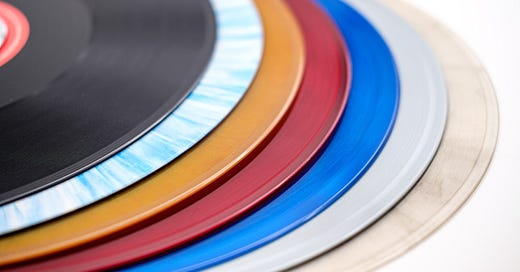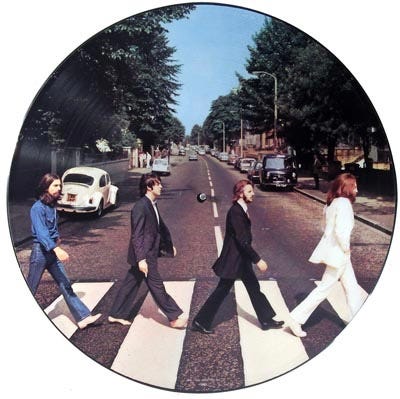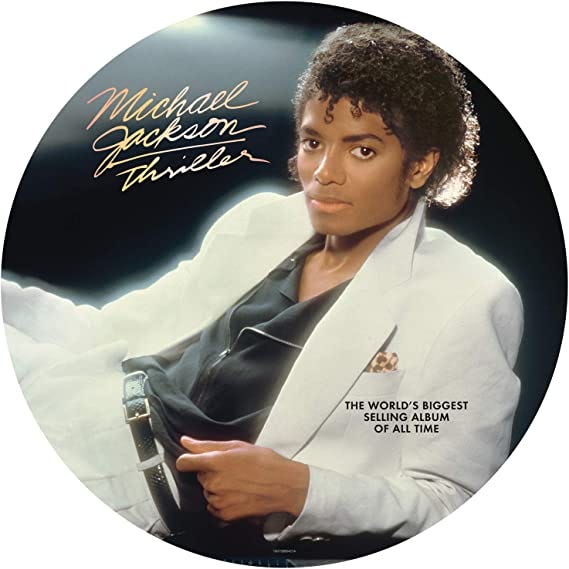Coloured vinyl and picture discs: sound quality
Do coloured records and picture discs sound better, worse or the same? Are some colours better than others?
To understand how the colour of a vinyl record can affect the way it sounds, we first need to know the basics of how records are made.
Records are made of (predominantly, but not exclusively) polyvinyl chloride (PVC). In its natural state, PVC is colourless with a white tinge. The black colour you associate with vinyl comes from another ingredient: black carbon. As well as giving records that timeless and distinctive black sheen, carbon strengthens records and makes them more durable.
Coloured vinyl
To create coloured vinyl, other ingredients, particularly dyes, are added to the mix. How all these ingredients “mould” together will have a significant impact on sound quality, overall performance and potential durability.
Some audiophiles will argue for or against certain colours. Many claim that translucent vinyl with a hint of colour sounds good, almost identical to black vinyl. Some swear they can hear differences between colours and will urge you to stay away from white vinyl, for example.
Colours can affect sound — but not for the reasons you think
In my experience, it’s tricky to make generalisations based purely on the colour of the record. A batch of records may have been rushed through production. Quality control may have been non-existent or very limited (this is true for coloured and black vinyl too).
Conversely, the pressing plant may have done an excellent job, and a coloured record may end up being one of the best sounding albums you own.
Generally, when it comes to sound quality, black vinyl tends to be a safer choice, simply because there is a wider pool of knowledge and expertise available in the industry. Not all pressing plants have coloured vinyl capabilities.
It’s a whole process
Making vinyl records is a complex process involving different materials and machinery. Crucially, the skill set of the individuals involved (and, quite frankly, the amount of time they have) is key.
A lot can go wrong during the manufacturing process or at quality control. Even the temperature and amount of pressure employed can impact sound quality and potential durability.
Some pressing plants have become more familiar with coloured vinyl in recent years. However, it’s not always feasible to spot defects when visually inspecting thousands of records at the eleventh hour.
Adding a funky colour to the mix complicates matters: some defects may get “camouflaged” into the colour or the individuals in question may be less familiar with certain shades or tones.
Limited editions, especially when numbered, tend to be safer, simply because fewer records had to be checked as part of that batch.
More colours = higher risk
Pastel and splatter coloured records can be riskier. The process involves at least two different colours, and not all colours blend or mould with the rest of the ingredients in the same way or at the same speed.
Splatter coloured records, in addition, due to the way they are made, will all look slightly different. This adds an extra hurdle at quality control.
Main factors
In sum, how well all the ingredients blend together, how much care was taken throughout, and whether any defects got rectified will have a greater influence on sound quality than the colour itself.
There is another factor that will have a tremendous impact on sound quality: mastering. I discuss this in more detail further down below.
The main takeaway is that coloured records will not always necessarily sound worse, but there is a higher risk for things to go wrong (or not as planned).
Results vary
Some coloured records are particularly “noisy” whereas others boast decent sound quality. I own some coloured records that sound better than some of my black vinyl. With others, however, I can immediately tell the sound is inferior.
If in doubt, check the reviews section of the specific release on Discogs. Collectors love to comment on coloured vinyl (positively and negatively), so you will probably find enough comments to help you decide.
Picture discs
Picture discs are made from a “sandwich” of materials. The first layer is generally a thin layer of polythene plastic. The actual image is printed on paper and placed on top of the first layer. The third layer consists of actual PVC, with another picture printed on paper sitting on the other side. Finally, another layer of clear plastic is added on top.
These layers are then “sandwiched” together using a vinyl press. The grooves containing the sound waves are transferred onto the top plastic layers.
Due to the thinness of the plastic containing the grooves, the sound is generally not as deep or warm. This often translates into increased surface noise and an overall lower-quality sound.
Besides, the material is not as durable, so picture discs tend to warp more easily.
While picture discs divide opinion, most collectors will claim that sonically they are inferior. This is a bit harsh, in my opinion. They will not always sound terrible, but due to the small amount of PVC involved, they just don’t have the same capability as a standard record.
It’s all about the mastering
As mentioned earlier, multiple factors can affect sound quality. Sometimes picture discs can give you a positive surprise. When this happens, it’s usually thanks to the mastering process.
Before a record is sent to a pressing plant, a sound engineer creates a master (i.e. the final “official” mix of a recording is transferred to a data storage device from which all copies will be made). The master for vinyl should (ideally) be different from the digital master used for CD and streaming.
If the master is below standard, the materials will need to be top notch for the record to stand a chance of producing a high-quality sound.
A standard black vinyl pressed from a digital or low-quality master may still sound acceptable to some listeners. This means that, at least, manufacturing went well. Besides, there is usually something else (typically, the quality of the PVC) that is compensating for the substandard master.
A picture disc has nothing or very little going in its favour in terms of the materials employed. That’s where a good master can shine.
Case study
Imagine a black vinyl record is being rushed through production. The master and/or materials used were of low quality. The record had to be on the market by a given date (e.g. Christmas), so everyone was rushing and cutting corners.
A couple of months later, say in June, a limited edition picture disc of the same album gets released. This time around, with less pressure and more time, they use a proper master, made exclusively for vinyl. Same pressing plant, but the workers are less stressed.
As this batch comprises, say, 500 records (as opposed to tens of thousands), quality control goes more smoothly.
The picture disc in this example will stand a good chance of actually sounding better than the standard black vinyl pressed in a rush a couple of months earlier.
Conversely, imagine it’s the picture disc that is being rushed through production to hit the stores in time for Christmas. You can imagine the result!
As you can see, within vinyl in general, there can always be discrepancies. Coloured records and picture discs are no exception.
The bottom line: good mastering, as well as skillful manufacturing, can make all the difference, particularly in the case of picture discs.
That’s all for now. Thank you for reading or listening and, as always, happy spinning!











The definite scuttlebutt back in the day (late '70s) was that pic discs (especially) and colored vinyl were lower quality (and, this without scientific study or any official read-out...we just put 2 and 2 together). Really to the point where you get the "street" disc sold at stores, and, if you dig the artist, you get the special disc as a "souvenir," maybe even hanging it up (as we've seen)😉!
Great stuff. And thanks it sharing the Discogs link.